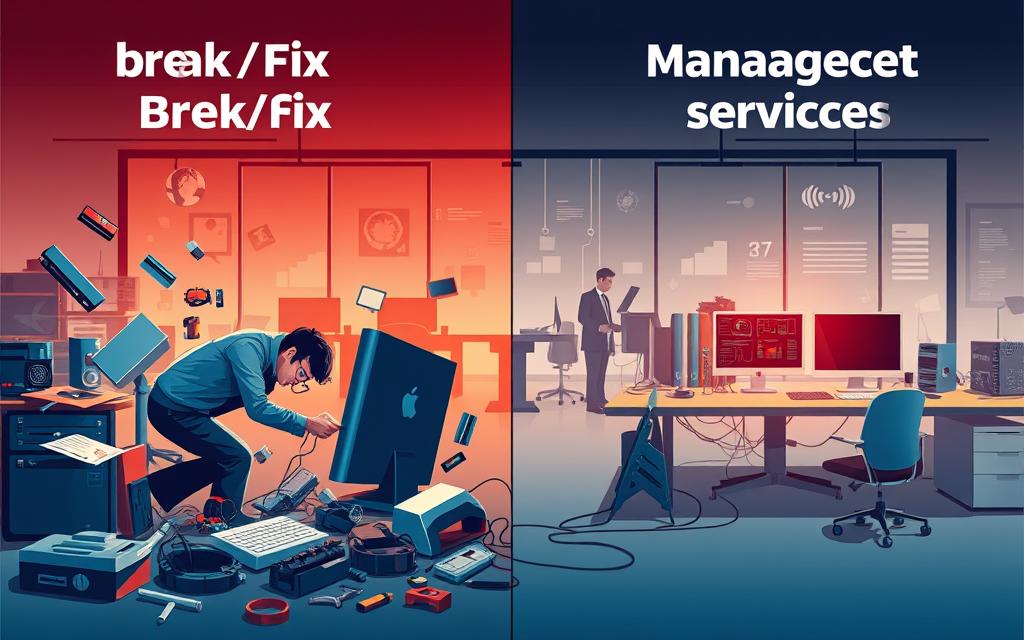Table of Contents
Many businesses rely on break/fix services for immediate tech support. This model involves paying per incident when hardware or software fails. Unlike proactive IT solutions, it’s reactive—providers step in only after problems arise.
Before managed services became popular, over 90% of companies used this approach. Common scenarios include server crashes, network failures, or malfunctioning workstations. The strategy offers short-term cost control, which explains why 42% of SMBs still use it today.
Modern IT now favors preventive solutions, but break/fix remains relevant for urgent repairs. Understanding its role helps businesses choose the right support model for their needs.
What Is Break/Fix in Computer Terms?
Tech issues can strike unexpectedly, forcing businesses to seek immediate solutions. The break/fix model addresses these emergencies with on-demand repairs, charging only when problems occur. Unlike subscription-based plans, it’s a pay-as-you-go system ideal for unpredictable needs.
Definition of Break/Fix IT Support
This support style involves troubleshooting after failures happen. Providers diagnose issues—like server crashes or malware attacks—and bill by the hour or flat rate. For example, virus removal averages $150, while hardware repairs can hit $200/hour.
How the Break/Fix Model Operates
Clients contact a provider only when systems fail. The process follows three steps:
- Issue reported: A workstation crashes or network slows.
- Diagnosis: Technicians identify the root cause.
- Resolution: Repairs are completed, often within 4–8 hours.
Small law firms might pay $1,750 for emergency server fixes instead of $3,000/month for managed services. The flexibility appeals to businesses with tight budgets or infrequent IT needs.
Niche areas like printer maintenance still thrive under this model. Point-of-sale systems also benefit, as retailers prefer per-incident pricing for seasonal demand spikes.
Break/Fix vs. Managed Services: Key Differences
Downtime costs drive the debate between two IT support strategies. While break/fix offers pay-per-use flexibility, managed services prioritize prevention. The choice hinges on budget, risk tolerance, and long-term goals.

Reactive vs. Proactive Approaches
Service providers using break/fix operate reactively—solving issues after they occur. Clients average 18 hours of downtime per incident (Kaseya 2023). In contrast, MSPs leverage RMM tools to reduce outages by 72%.
Security gaps highlight the risks of a reactive approach. SonicWall’s 2024 report found 83% of cyberattack victims relied on break/fix. Managed contracts include SLA-backed guarantees, whereas break/fix offers “best effort” resolutions.
Cost Structures Compared
Break/fix appeals to businesses with infrequent IT needs, saving 23% annually for low-tech operations. Tech-dependent firms gain 31% higher ROI with managed services, thanks to predictable budgeting.
| Factor | Break/Fix | Managed Services |
|---|---|---|
| Response Time | 24+ hours | ≤4 hours |
| Pricing Model | Per incident ($150–$200/hr) | Fixed monthly fee |
| Security Focus | Post-breach fixes | Preventive monitoring |
Hybrid models bridge the gap, adopted by 29% of enterprises (Gartner). These blend on-demand repairs with scheduled maintenance, balancing cost and reliability.
Advantages of the Break/Fix Model
Seasonal enterprises often prefer break/fix services for their budget-friendly structure. This model adapts to fluctuating demands, ensuring businesses pay only for urgent repairs. A TechTarget survey found 61% of users value its no vendor lock-in policy, avoiding long-term commitments.
Cost Control and Flexibility
Restaurants exemplify the cash flow benefits. One chain saved $18k annually by using on-call support during peak seasons. Break/fix aligns with variable costs, unlike fixed-fee contracts that charge for unused services.
BYOD environments also benefit—74% of self-managed devices (Forrester) reduce internal maintenance needs. Cloud-based tools further cut expenses, as providers handle updates and parts replacements.
No Long-Term Commitments
Legacy systems often require specialized repairs. Break/fix caters to these niche needs without forcing upgrades. For example, manufacturing firms using outdated machinery avoid costly overhauls with targeted fixes.
Hybrid setups blend break/fix with preventive care. This balances flexibility and reliability, ideal for businesses testing IT scalability.
Disadvantages of Break/Fix IT Support
Unexpected IT failures under break/fix can spiral into costly disruptions. This reactive approach leaves businesses vulnerable to extended outages and hidden expenses. While suitable for minor issues, the model struggles with complex system failures.

Potential for Extended Downtime
Mid-sized retailers lose $5,600 hourly during outages (ITIC 2024). Break/fix providers often take 24+ hours to resolve critical downtime, as they prioritize emergencies case-by-case. Without proactive monitoring, minor glitches escalate into full-blown crises.
Security breaches worsen under delayed responses. Companies using break/fix take 22% longer to contain attacks than those with managed services.
Unpredictable Repair Costs
Spiceworks found 34% of clients face “bill shock” from unexpected fees. Hourly rates vary widely:
| Service | Average Cost | Managed Alternative |
|---|---|---|
| Data Recovery | $3,000+ | $500/month backups |
| Hardware Markup | 18–35% premium | Wholesale parts |
Supply chain delays further inflate expenses. A single server repair can cost 3x the projected budget due to part shortages.
Common IT Issues Addressed by Break/Fix Services
From crashed workstations to network outages, break/fix providers handle critical failures. CompTIA reports 78% of service calls involve urgent hardware or software repairs. This reactive model excels at restoring operations when systems fail unexpectedly.

Hardware Failures and Repairs
Workstation breakdowns dominate service requests. HDD replacements account for 32% of cases, followed by power supply swaps (28%) and screen repairs (19%). Technicians often stock common parts to reduce downtime for business-critical devices.
Emerging IoT demands add complexity. Smart office sensors and HVAC controls now represent 12% of break/fix cases—a 140% YoY increase.
Software Glitches and Network Problems
Windows OS errors cause 64% of software issues, while application conflicts trigger 22% of crashes. Break/fix teams use standardized troubleshooting trees to isolate conflicts rapidly.
Network outages require layered solutions. Providers typically:
- Coordinate with ISPs to verify external connectivity
- Reset router configurations to factory defaults
- Inspect physical cabling for damage
Data recovery success rates vary by failure type. Logical errors like corrupted files have 89% recovery odds, while physical damage drops chances to 43%. Proactive backups remain the best defense against permanent data loss.
Is Break/Fix Right for Your Business?
Growing businesses face a critical decision: reactive fixes or proactive monitoring? The break/fix model suits some businesses but becomes inefficient as operations scale. MSPAlliance data shows companies with 50+ employees or $2M+ revenue typically transition to managed services.

Assessing Your IT Needs
Evaluate three core factors:
- Company size: Break/fix works for small teams with simple infrastructure.
- IT complexity: Multi-site networks demand continuous monitoring.
- Compliance needs: HIPAA or PCI rules often require MSPs for audit trails.
Warning signs for an upgrade include 3+ monthly outages or IT budget swings exceeding 15%.
When to Consider Managed Services
Managed services prevent crises before they disrupt workflows. A manufacturing plant combined MSP oversight with break/fix for legacy CNC machines, cutting downtime by 41%.
| Scenario | Break/Fix Fit | Managed Services Fit |
|---|---|---|
| Under 20 employees | High | Low |
| Data-sensitive operations | Low | High |
| Seasonal demand spikes | Medium | Medium (hybrid) |
For scaling SMBs, a phased transition roadmap ensures infrastructure stability. Start with critical systems under MSP contracts, retaining break/fix for niche needs.
Conclusion
The break/fix model remains a vital option for certain operational scenarios. While managed services dominate modern IT, reactive support excels in industrial sectors with legacy systems or seasonal demands.
Businesses should assess downtime tolerance and compliance needs. Industrial segments will drive 19% annual growth for break/fix, per TechValidate.
For optimal results, blend both models. Use managed services for critical systems and break/fix for niche repairs. Need guidance? Consult an IT strategist to tailor a support plan.
FAQ
What does break/fix mean in IT?
Break/fix refers to a reactive IT support model where technicians address issues only after they occur. Businesses pay per incident for repairs, hardware replacements, or software troubleshooting.
How does break/fix differ from managed services?
Managed services offer proactive monitoring and maintenance, while break/fix operates on-demand. The former prevents problems; the latter resolves them after downtime occurs.
What types of IT problems do break/fix providers handle?
Common issues include hardware failures, network outages, software crashes, and security vulnerabilities. Providers diagnose, repair, or replace malfunctioning components.
Why do some businesses prefer break/fix support?
Smaller organizations often choose this model for its pay-as-you-go flexibility and absence of recurring fees. It suits companies with infrequent IT needs or limited budgets.
What are the risks of relying on break/fix solutions?
Unexpected downtime and variable costs can disrupt operations. Without proactive monitoring, minor issues may escalate into major system failures.
When should a company switch to managed services?
Businesses experiencing frequent outages, security breaches, or growth should consider managed IT. Continuous monitoring improves system reliability and reduces emergency repair costs.
Can break/fix providers address cybersecurity threats?
They can remediate attacks after detection but lack preventative measures like real-time threat blocking offered by managed security service providers (MSSPs).
How do break/fix costs compare to managed services?
While break/fix avoids monthly retainers, cumulative incident-based fees often exceed predictable managed service pricing over time.









